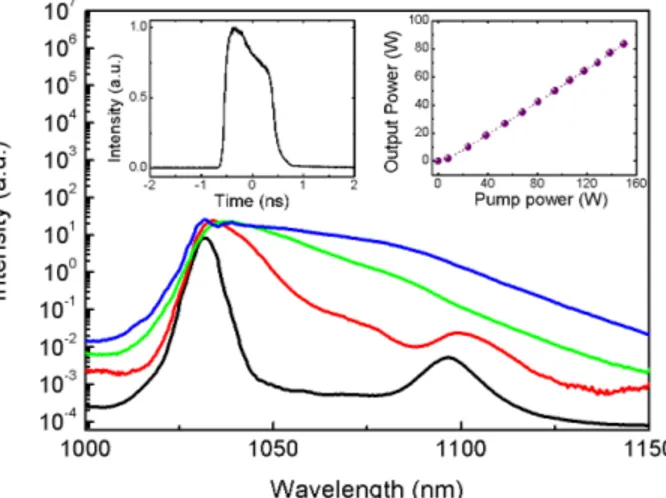83 W, 1 ns, 3.1 MHz all-fiber laser for micromachining
Kıvanç Özgören1, Bülent Öktem1, Sinem Yılmaz2, F. Ömer Ilday2, Ece Pasin3, Koray Eken3
1Material Science and Nanotechnology Graduate Program, Bilkent University, 06800, Ankara, Turkey
2Department of Physics, Bilkent University, 06800, Ankara, Turkey
3FiberLAST, Ltd., 06531, Ankara, Turkey
Fiber lasers are commonly used for various material processing applications. The advantages (such as simplicity of the system, high material removal rate) and disadvantages (larger heat-affected zone, reduced precision) of nanosecond pulses over sub-picosecond pulses are well known.
Here, we report on a simple, all-fiber-integrated fiber laser generating 1-ns-long pulses. This duration is long enough that sustained plasma formation should lead to efficient ablation, but short enough to limit the heat-affected zone (HAZ). The oscillator operates in a commonly encountered, but usually ignored mode, producing stable pulses, which cannot be compressed to transform limit [1]. An all-fiber-integrated oscillator with a nonlinear optical loop mirror (NOLM) seeds an all-fiber-integrated Yb-fiber amplifier (core diameter of 25 µm, cladding diameter of 250 µm) at a repetition rate of 3.1 MHz (Fig.1). Fig. 2 shows the optical spectrum at various output powers. The growing influence of Raman amplification is evident, confirming the high peak power of the source. The pulse duration is measured with a sampling scope to be 0.9 ns, unchanged at all power levels. The maximum output power is 83 W, corresponding to ~26 µJ of pulse energy and 25 kW of peak power. The RF spectrum is free of modulations down to -70 dBc. The short-term power stability of the pulse trains obtained directly from the oscillator and at the full power of the amplifier are characterized by their integrated (over the range 3 Hz – 250 kHz) relative intensity noise using the standard method [2] to be 0.6% and 1.86%, respectively. In order to test the utility of this system for material processing, we used a galvo scanner, followed by an f-theta objective, which focuses the beam to a spot size of 20 µm. As target, we used polished titanium surfaces. For this target, only 2 W of average power was sufficient. For comparison, we used an industrial fiber laser producing 70 ns-long pulses and a home-built fiber chirped-pulse amplifier (CPA), which delivers 20 ps-long pulses without external compression. SEM analysis of the processed samples reveals that the HAZ is significantly reduced compared to the nanosecond system, and nearly the same as that of the 20-ps system.
In conclusion, we report on a high-power and misalignment-free integrated Yb-doped fiber laser-amplifier, with ~80-W, 1 ns-long pulses at 3.1 MHz. We utilize it in micromachining of Ti surfaces with reduced HAZ. To our knowledge, this is the first use of square-pulse generation from fiber lasers in material processing.
Fig. 1. Schematic diagram of the oscillator-amplifier setup. WDM: wavelength-division multiplexer; MPC: multiple pump combiner; LMA: large mode area.
Fig. 2. Optical spectra measured directly from the oscillator (black line), and at output powers of 26.6 W (red line), 57.4 W (green line), 81.8 W (blue line). Insets: temporal profile of the 0.9-long pulses and output power vs. pump power.
References
[1] L. M. Zhao, D. Y. Tang, T. H. Cheng, and C. Lu, “Nanosecond square pulse generation in fiber lasers with normal dispersion,” Opt. Comm. 272, 431 (2007).
[2] R. P. Scott, C. Langrock, and B. H. Kolner, “High dynamic range laser amplitude and phase noise measurement techniques,” IEEE J. Quantum Electron. 7, 641 (2001). !"#$"%&# '(#)*# (+,#)-# +,,#)*# ')# .,/# ,0+)# 1)# +1)# 23#)*# 4,/# !"#$%# &'#$%# "(#$%# ))#$%# *+#$%# ),)#$%# &'#$%# &,'#$%# ',/# 2,/# :;<8=9<&# ',#5)#6789%&# *>?# 15@#A<BC8%&# ';9#A<BC8%&# ,0()# D B9C B9# A<BC8% &# 1)# 1)# 1)# ')# ?EA# 1+*#F7GF#C<H%&# CB)C#@7<@%;# :; <8=9< &# !"#$"%&# *>?# 4,,#)-# 3,,#)*# I?-#!"#$"%&# '(,#)*# ))#$%# &",'#-%# 2.#*# 100 µm
